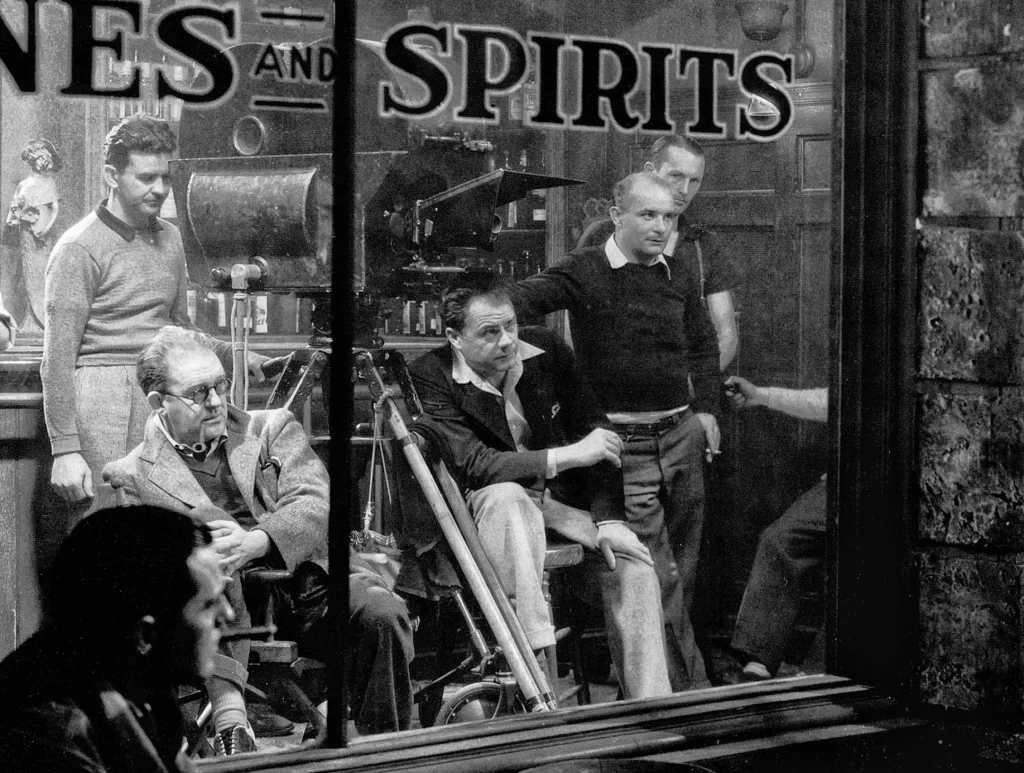Codifications of the 1930s:
Hopping on the train and heading back to mid-thirties American cinema isn’t always the easiest for a modern audience. I find they have a difficult time allowing pre-method performances to resonate. The codifications of emotion are more embellished than in today’s cinema, so perhaps we think a performance is “overplayed” and therefore unrealistic. But as Scorsese is on record as saying, these codifications have their own truths that we can find insightful. I think watching The Informer taught me that these codifications have their own use, and we can still relate to more overt emotion and performance IF and only IF a few boxes are checked, namely, tone and style.
In the first several minutes, Ford visually sets up the film’s tone and tension. With nothing more than a shadow on a wall, soon eclipsed by lead Victor McLaglen as Gypo Nolan, we see a distressed man in a shadowy, foggy atmosphere that illustrates Gypo’s inner turmoil as a poor, desperate Dubliner. He looks at a poster of Frankie McPhillips, a fugitive with a 20 pound reward on his head. We learn he and Franke are old friends via an optical overlay of them drinking together. Next, Gypo beats up a man who approaches a prostitute, his girlfriend, who wants nothing more than for her and Gypo to go to America–for 10 pounds per ticket. Now we as an audience have the satisfaction of putting this all together, allowing us insight for what is to come. This, coupled by the incredible visual atmosphere, allow us as an audience to buy-in, be it in 2022 or 1935.
As mentioned by Craig Hammill before the screening at SMC began, the low-budget film did not have intricate sets or physical locations to exploit. Ford, along with cinematographer Joseph August, had to make bold creative decisions to hide their painted, cheap sets. Fog, shadows, low-key lighting–all of this, a precursor to the next decade’s explosion of American Film Noir–amplifies the film’s style quickly and effectively. As Harry Burdick states in the June, 1936 issue of American Cinematographer: “There is no drab middle ground; [August’s] unbridled virility and boldness of artistic expression forbid any such indifference.” No middle ground. Filmmakers will have to make hard, bold choices to conceal a lack of resources, which even at the highest levels become scarce at some point. What I’ve been keeping an eye out for at these Ford screenings are the technical decisions he and his team made to push the story forward–How craft, by restriction of resources, can be elevated to artistry. For me, tt’s very important I think of cinema as something achieved rather than something taken for granted.

Moments:
Gypo attends Frankie’s wake after informing on him. The money he was rewarded for doing so falls out of his pocket (in the form of 4 coins) and spin on the floor right in front of Frankie’s mother. Is this poetic or sentimental? Or both? Whatever it is, I think it’s a brilliant, visual way of writing a scene with clear Catholic guilt overtones. I’d like to call back to my point above about codifications. Guilt here is shown by the coins falling on the floor. In a more modern film, let’s use The Departed as an example since it’s so influenced by The Informer even to the point that a character is watching it in Scorsese’s film. The guilt-ridden Billy Costigan character doesn’t have a few coins he can drop out of his pocket, but he has Oxycontin, a therapist (who he has sex with) and a coat-hanger to gauge a Rhode Islander’s eye out with.
When Gypo is shot at in the final moments of the film, I feel it. I think it’s because Ford is so frank and unsentimental about this moment of the film. Gypo opens the door and we cut to a straight-away medium shot of the shooter, who in this same frame, shoots at the camera. No music, just gun shots. It happened. Nothing else is needed to convey emotion. It’s brilliant restraint.
Killing a character off in front of loved ones, no matter what, is always a gut-wrenching experience. Here, you can feel it when Frankie is killed by the mob at his house. We only see him from the poster and from one scene across from Gypo, but again Ford’s style is so unflinching, from the banging through of the front door to the sister being caught in the middle of the gunfire, to finally Frankie falling out the window, it cuts deep with the poor guy’s mother there.